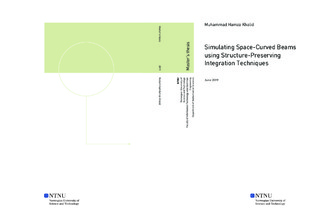| dc.description.abstract | Spatial deformations in beams subjected to terminal twist and axial compression is a significant engineering problem. When compressed more than a limit, the geometry becomes complex and rods form a loop with itself. This unstable behavior is essential to understand post-buckling in rods. The mathematical model used for the analysis of nonlinear deformations is a boundary value problem with a system of ordinary differential equations in space.
In the present work, we use geometric integration schemes to study the deformations in space–curved beams subjected to twist and vertical compression. We present a numerical setup for the solution of boundary value problem and simulate commonly observed phenomena such as loop formation, axial shortening, and self–contact. We also study the conservation properties in space, and numerically compare the preservation performance of structure preserving schemes with non–preserving integration schemes, for a twist–shortening problem. A multi–symplectic formulation for space–curved beams is also derived and numerically implemented using RATTLE and symplectic Euler method. The theoretical and numerical setup presented here will be useful to understand relatively
complex dynamic problems. | |
